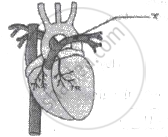Advertisements
Advertisements
Question
Describe the events in cardiac cycle. Explain “double circulation”.
Solution
The events in the cardiac cycle is-
1. Atrial Systole (0.7 sec): When the SA node initiates a wave of contraction, the atria contract. Because the two valves are open, blood flows through the ventricles.
2. Ventricle Systole (0.5 sec): Following this, the AV node initiates a wave of contraction, which causes the ventricles to contract. As a result, the two valves close and the first heart sound, 'lub,' is created.
3. Complete Ventricular Systole: The semilunar valves open after ventricular contraction, allowing blood to pass into the pulmonary trunk and aorta.
4. Ventricular Diastole: In this condition, the ventricles relax and the semilunar valves shut, resulting in a 'dub' heart sound.
5. Complete Ventricular Diastole: As the pressure in the ventricles decreases and blood flows from the atria to the ventricles, the bicuspid and tricuspid valves open. The cycle will take 0.8 seconds to complete.
Deoxygenated and oxygenated blood stay separate and do not combine in double circulation.
APPEARS IN
RELATED QUESTIONS
What is meant by the term 'Double circulation'?
What is the difference between pulmonary circulation and systemic circulation?
Explain the Term
Double Circulation
In the given diagram, 'X' indicates ______

Select the correct option:

What is the significance of hepatic portal system in the circulatory system?
Oxygenated blood to the liver is supplied by ______.
The blood vessel which carries blood from the stomach and intestine to the liver:
Name these:
Two phases of circulation of blood in human body
Write important role/roles of the following:
Hepatic portal vein
